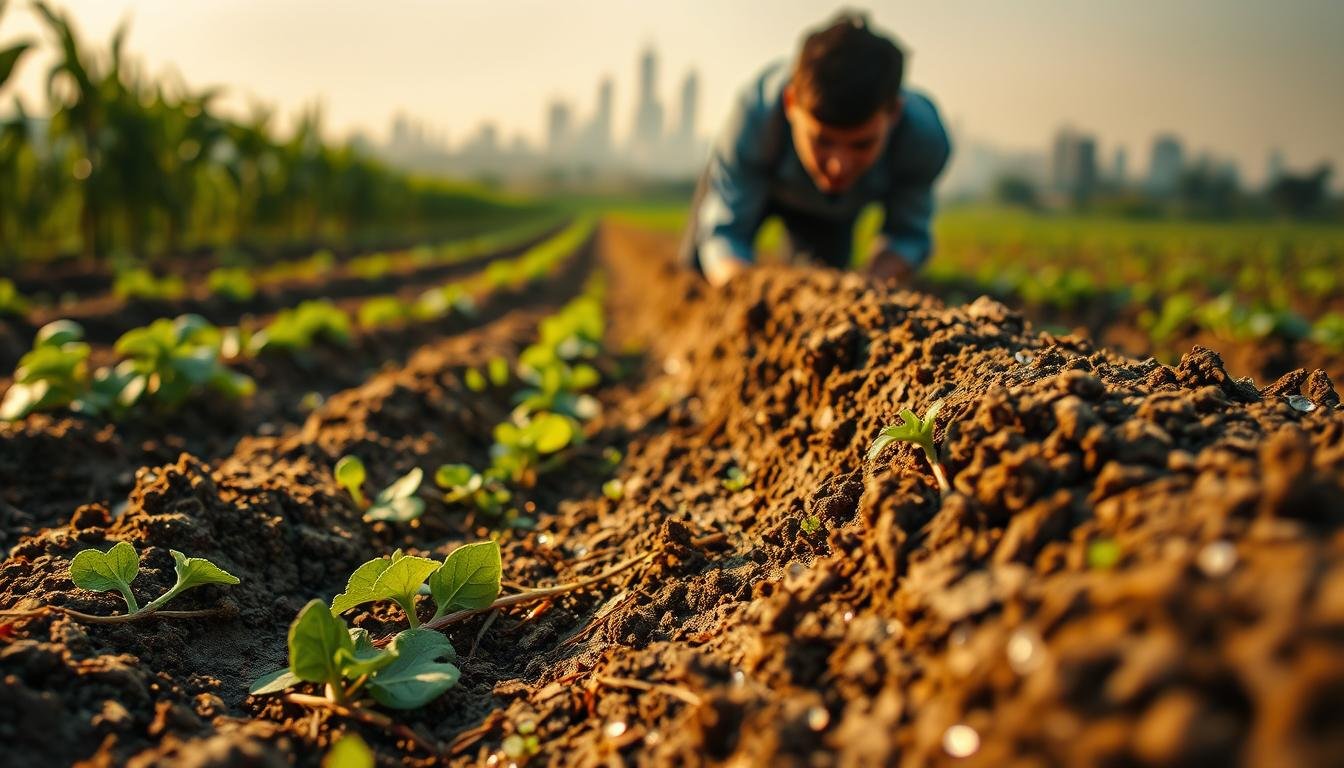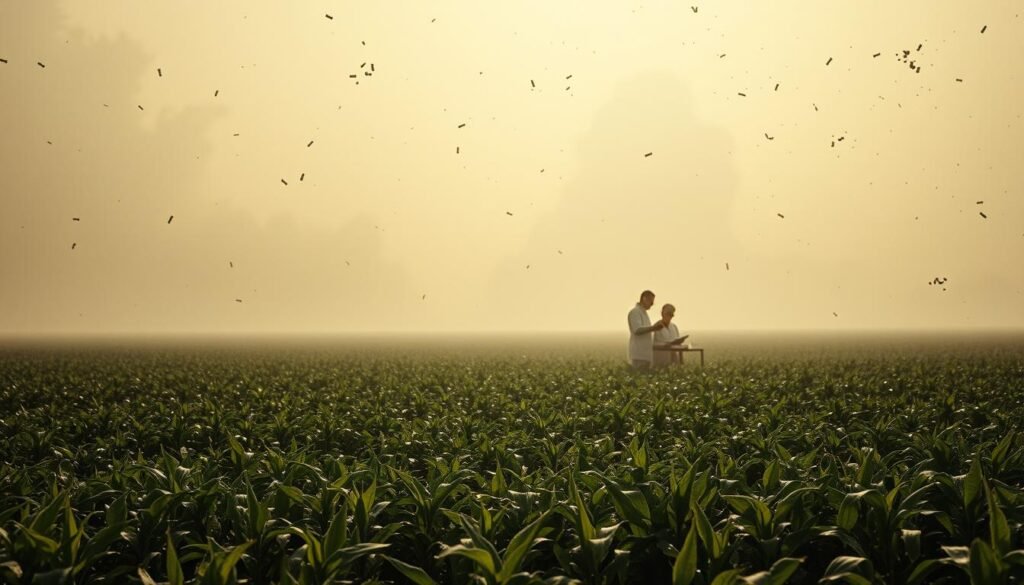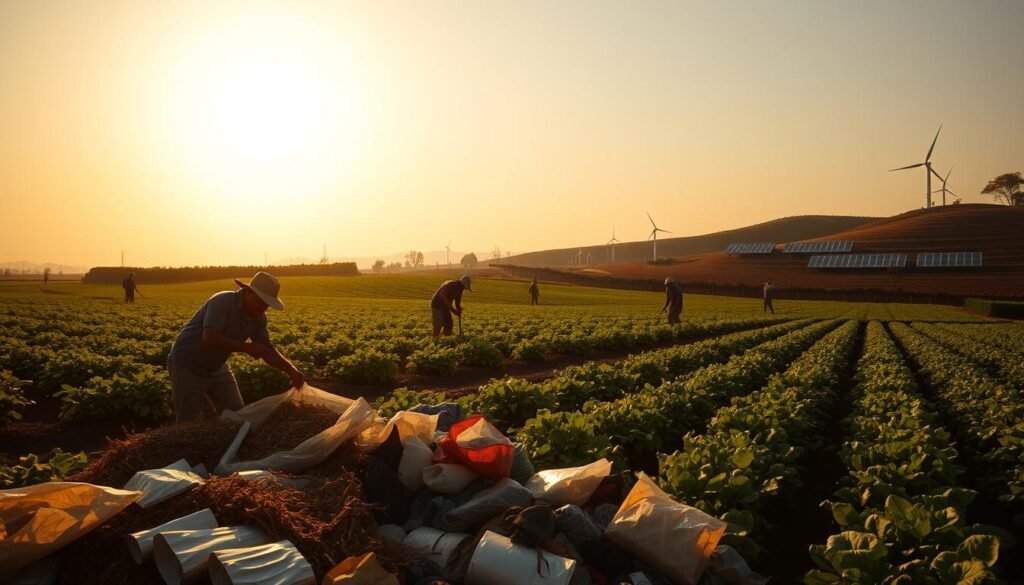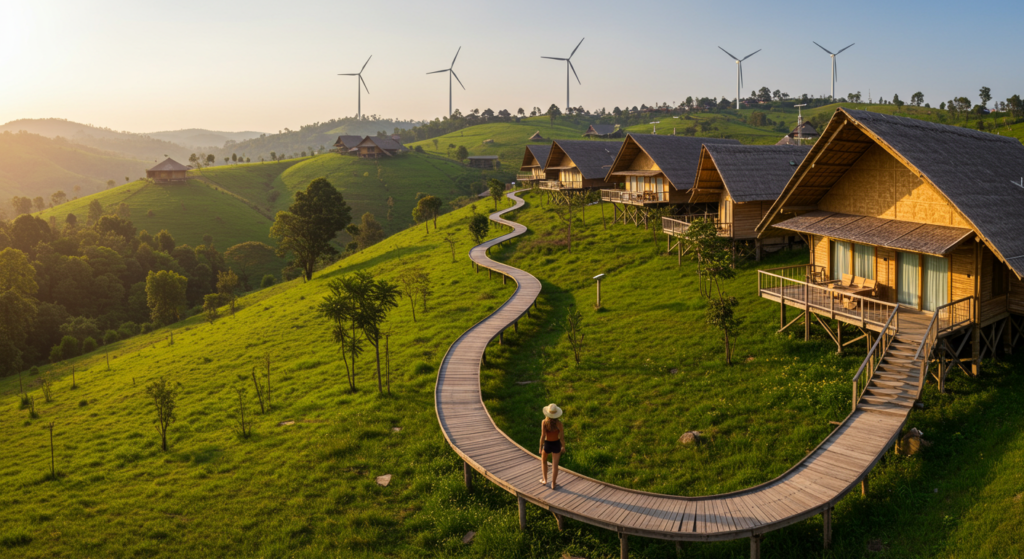
Did you know tiny plastic particles in your soil could harm the food you eat? Microplastics, small pieces from plastic waste, are found in farmlands all over the world. These pollutants were once thought to only affect oceans, but now they play a big role in harming our environment.
As plastic waste gets into soil and water, it’s not just nature that’s at risk. Our food systems are also in danger. This is a serious issue that we need to address.
Key Takeaways
- Microplastics are tiny plastic particles from everyday items, now pervasive in soil and water.
- They harm plant growth and reduce crop yields, threatening food production.
- Contaminated crops could spread these pollutants into our diets, raising health risks.
- Plastic pollution in agriculture is worsening globally, with no region untouched.
- Protecting food security means addressing microplastics in farming practices today.
Microplastics in Agriculture Impact of Microplastics on Plants Plastic Pollution: Understanding the Growing Crisis
Farmlands in the U.S. and around the world face a hidden threat. Microplastics are now common in agricultural soils. These tiny particles, often too small to see, are accumulating in fields where our food grows. This problem isn’t just local; it’s a global challenge that scientists are studying urgently.
The Alarming Rise of Plastic Contamination in Farmlands
Microplastics in soil aren’t a mistake—they’re a result of modern farming. Plastic mulch, used to keep soil moist, breaks down into microplastics that last for decades. Studies show U.S. corn and soybean fields have up to 50 microplastic particles per kilogram of soil. This is double the amount found in urban areas.
How Microplastics Enter Agricultural Systems
Here’s how plastic pollution gets into farmlands:
- Water Sources: Irrigation water carries microplastics from treated wastewater.
- Fertilizers: Sewage sludge used as fertilizer often contains microplastic residues.
- Airborne Pollution: Wind carries microplastics from urban areas to rural fields.
- Plastic Mulch Breakdown: Degraded plastic sheets become soil contaminants.
The Scale of the Problem: Current Research and Findings
Recent data shows alarming trends. A 2023 study in Environmental Science & Technology found U.S. agricultural soils contain 10–50 microplastic particles per kilogram. This is higher than urban soils in some areas. Globally, rice paddies in Asia and European vineyards show similar contamination levels. These numbers show how microplastics and their role in environmental degradation now threaten ecosystems far beyond landfills.
How Microplastics Disrupt Plant Growth and Development
Scientists are finding out how tiny plastic particles in soil harm plant growth. These plastics can stop roots from growing and block nutrients. This is a big problem for food all over the world. Let’s look at the science behind how do microplastics affect plant growth and why it’s important for our food.
- Roots struggle to spread: Microplastics form barriers that limit root expansion, trapping water and nutrients far from plant systems.
- Nutrient highways blocked: Particles trap nitrogen and phosphorus in soil, leaving plants malnourished and vulnerable to disease.
- Seeds falter: Germination rates drop by up to 50% in heavily contaminated soil, studies show.
- Stunted growth cycles: Plants in polluted soil often grow smaller leaves and weaker stems, reducing overall crop yields.
“Microplastics act like invisible anchors, holding back plant progress at every stage of life,” noted a 2023 study in Environmental Science & Technology.
The microplastics in agricultural soil: risks and solutions debate is urgent. Soil changes caused by plastics reduce water retention. Plants have to “drink” contaminated water. Some crops even absorb microplastics, affecting their health.
Farmers might soon find tomatoes with plastic inside their stems. These issues aren’t just lab results. They’re a quiet crisis changing what we eat.
The Looming Threat to Global Food Production and Security
Imagine a world where crops like rice, wheat, and corn can’t grow well because of tiny pollutants. The can microplastics reduce global food production is a real worry for scientists. Studies show that microplastics in soil can slow down plant growth, cutting yields by up to 20% in some areas. Farmers in the U.S. Midwest, where plastic mulch is common, face a big threat.
Can Microplastics Reduce Global Food Production?
- Corn yields in test plots exposed to microplastics dropped by 15% (University of Minnesota, 2023).
- Wheat roots absorb microplastics, disrupting nutrient uptake critical for healthy growth.
Contamination Concerns in Food Chains

Microplastics in crops can end up in livestock and our food. A 2022 FDA report found microplastics in 90% of leafy greens.
“These particles don’t just weaken plants—they enter our bodies through every food chain step,”
says Dr. Elena Torres, environmental scientist at Stanford. This raises questions about long-term health risks beyondhow plastic waste impacts food security.
Vulnerable Regions and Populations at Greatest Risk
Small-scale farmers in India and sub-Saharan Africa are at high risk. In the U.S., low-income areas with contaminated water, like parts of Flint, Michigan, are also at risk. Families in these areas often rely on local agriculture, making them the first to face shortages.
Combating Agricultural Plastic Pollution: Strategies and Solutions
From policy changes to everyday choices, strategies to decrease plastic pollution are underway. Collective action is reshaping farming practices and protecting food systems.

Global Initiatives and Policy Approaches
Legislation is key to change. The EU’s Single-Use Plastics Directive bans certain plastics by 2026. The U.S. National Plastic Stewardship Strategy aims for safer waste management.
Farmers in California get grants for biodegradable materials through the Agricultural Plastic Recycling Program.
“Strong policies turn awareness into action,” says the EPA’s 2023 report on microplastic mitigation.
Innovations Shaping Sustainable Farming
- Biodegradable mulch films (e.g., Vegeplast) naturally break down, reducing soil contamination.
- Companies like AgriCycle offer compostable plant pots, cutting plastic use by 40% in pilot farms.
- Smart irrigation systems minimize plastic waste by optimizing water use, as seen in Nebraska’s eco-friendly cornfields.
Individual Actions for Change
Everyone can help in global and individual initiatives to combat the problem. Here are some steps:
- Buy produce from farms certified as plastic-neutral (search USDA’s Environmental Stewardship directory).
- Advocate for local bans on non-recyclable agricultural plastics via petitions or town halls.
- Compost food waste to reduce packaging reliance—cities like Portland offer free compost bins for households.
Small steps add up. By choosing recycled or reusable products and supporting eco-conscious policies, consumers drive change. Together, we can redefine agriculture’s future, one sustainable choice at a time.
Conclusion: Securing Our Food Future in the Face of Plastic Pollution
Microplastics in agriculture are a big problem, not just for the environment but for our food too. They harm plant growth, pollute food chains, and hurt vulnerable communities. But we can fight this crisis together, using new ideas and working as a team.
Big steps like banning single-use plastics and working with eco-friendly suppliers are key. Companies using biodegradable materials and governments funding green farming are crucial. We can all help by using less plastic, supporting local farms, and pushing for change.
We need to act fast and work together to save our food future. By combining policies, technology, and our daily choices, we can protect our planet and feed our children. Let’s make a difference by taking action today.
100% Portable Power-Bill Slashing Solution

FAQ
What are microplastics, and how do they enter agricultural systems?
Microplastics are tiny plastic pieces smaller than 5mm. They get into farms through water, sewage, and even the air. This happens when plastic breaks down or is carried by wind.
How do microplastics affect plant growth and development?
Microplastics can harm plants by messing with their roots and how they absorb nutrients. They can also change the soil, making it harder for plants to get water and nutrients. This can lower crop yields.
Can microplastics reduce global food production?
Yes, microplastics in crops can lower yields, especially for important food crops. If plants absorb these plastics, it could make food less safe and nutritious. This could threaten our food supply worldwide.
What risks do microplastics pose to our food chains?
Microplastics can get into plants and then into our food. This is a big concern for food safety. It could harm people, especially in areas where food is scarce.
What are some strategies to decrease plastic pollution in agriculture?
We can use biodegradable plastics instead of regular ones. We should also work on reducing plastic use and improving how we manage waste. Practices like crop rotation can help too.
Are there global initiatives in place to combat microplastic pollution?
Yes, there are worldwide efforts to cut down plastic use in farming. These include policies and sustainable packaging solutions. They involve governments, industries, and communities working together.
What can individuals do to reduce plastic impacts on food systems?
We can all help by choosing to buy less plastic. Supporting local farms and pushing for laws to reduce plastic pollution are good steps. These actions can make a big difference.
How do microplastics contribute to environmental degradation?
Microplastics pollute soil and water, harming ecosystems and biodiversity. They disrupt soil life, leading to ecological problems. This affects the health of our planet.
What are the implications of microplastics for food security?
Microplastics in farming can harm food security by reducing crop yields and affecting nutrition. They can also pose health risks, especially for those who are already struggling to get enough food.






